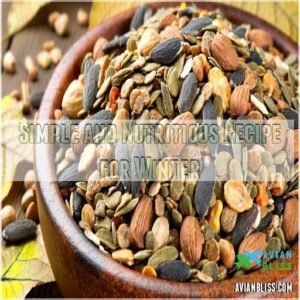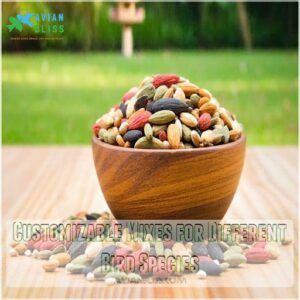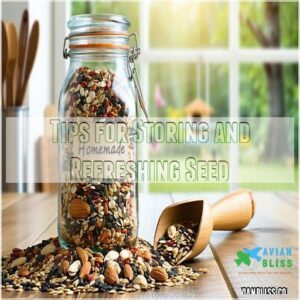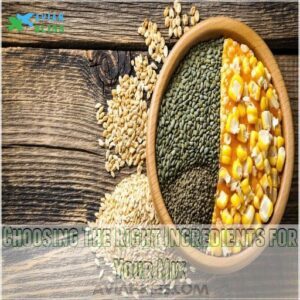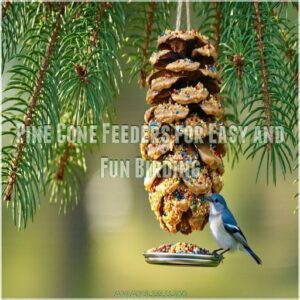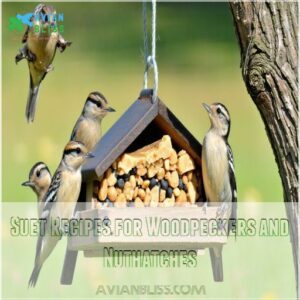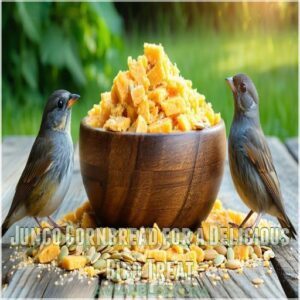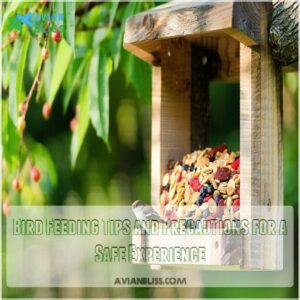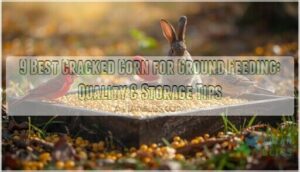This site is supported by our readers. We may earn a commission, at no cost to you, if you purchase through links.
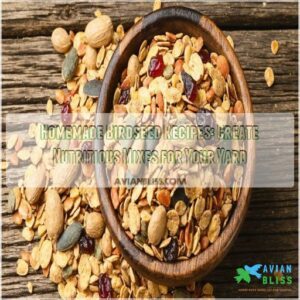
Start with sunflower seeds for protein and fat, toss in millet for antioxidants, and shelled peanuts for healthy fats.
Whatever you do, skip the bread and salty snacks—they’re bad for bird tummies.
Mix it up for a customized blend that suits local species and fits your budget.
Plus, it’s a greener choice, reducing waste from store-bought options.
Curious about more tips and tricks to keep your backyard bustling with birds?
You’re in the right place!
Table Of Contents
- Key Takeaways
- Benefits of Homemade Bird Seed
- Best Homemade Birdseed Recipes Available
- Choosing The Right Ingredients for Your Mix
- DIY Bird Feeders and Recipes to Attract Birds
- Bird Feeding Tips and Precautions for a Safe Experience
- Frequently Asked Questions (FAQs)
- What is the best homemade bird feed?
- Can I make my own bird seed mix?
- Is it cheaper to make your own bird seed?
- How do you make a simple bird feed?
- How long does homemade bird seed last?
- Can birds eat spicy seeds or nuts?
- Which birds prefer sunflower seeds most?
- Is it safe to add dried fruits?
- How do I store extra bird seed?
- Conclusion
Key Takeaways
- Create homemade birdseed mixes using sunflower seeds, millet, and peanuts to give local birds nutritious and tailored meals, cutting down on waste and costs.
- Skip bread and salty snacks since they’re harmful to birds; instead, provide healthy snacks that match your region’s feathered inhabitants’ preferences.
- Store your birdseed in airtight containers in cool, dry places to keep it fresh and free from unwanted critters or moisture.
- Regularly clean feeders to prevent disease, ensuring they remain safe environments for your backyard visitors.
Benefits of Homemade Bird Seed
Making your own bird seed isn’t just a fun way to attract feathered friends—it’s also a chance to tailor each mix to the specific needs of your local birds while saving money.
Plus, by using quality ingredients, you’ll guarantee your backyard diners get the best nutrition, all while cutting down on waste and discouraging pesky critters.
Essential Ingredients for Bird Health
Want healthier birds? Make your own birdseed!
Three key birdseed ingredients are sunflower seeds (packed with fat and protein!), white millet (calcium boost!), and cracked corn (fiber!).
These provide essential birdseed nutrition, giving your feathered friends the energy they need.
Get creative with your DIY seed mixes – it’s easy, fun, and you’ll see the difference!
Customization Options for Local Bird Species
You’ve got the power to tailor your birdseed mix to the unique tastes of local bird species.
Just like you might prefer certain snacks, birds in different regions have their favorite seeds.
By knowing your feathery visitors’ feeding habits, you can whip up a mix that caters to their specific seed preferences, including a blend of sunflower seeds and nuts, ensuring your yard becomes their go-to buffet.
Cost-Effective and Environmentally Friendly
Rather than sticking to store-bought mixes, try crafting your own birdseed recipe for a more personalized touch.
It’s not just about feeding birds; you’re also cutting costs and embracing eco-friendly practices.
By using organic supplies in your birdseed mix, you help local feathered friends flourish while keeping things on a budget.
It’s both sustainable feeding and smart living!
Best Homemade Birdseed Recipes Available
You can whip up birdseed mixes that are simple and packed with nutrition, keeping your feathered friends happy even during winter chills.
With a dash of creativity, you can tailor your recipes to cater to the specific birds visiting your backyard, ensuring everyone gets a tasty treat!
Simple and Nutritious Recipe for Winter
Winter is tough for birds, and you can be their superhero with a simple and nutritious birdseed mix.
Blend 1 cup of black oil sunflower seeds, 1 cup of chopped peanuts, 1/2 cup of striped sunflower seeds, and 1/2 cup of cracked corn.
Rich in fats and proteins, this budget-friendly mix will keep them chirping happily through the cold months.
Customizable Mixes for Different Bird Species
Crafting birdseed mixes lets you tailor recipes to your local bird populations‘ tastes.
By choosing seeds like sunflower seeds, which are a favorite of finches and sparrows, you can adjust easily.
Customization increases your success, like having a personal chef for each bird species.
Try a DIY mix with favorite seeds and watch your backyard transform into a vibrant bird haven!
Tips for Storing and Refreshing Seed
Keeping your homemade birdseed fresh is like maintaining a well-stocked pantry.
Start with airtight containers to boost seed longevity and keep humidity at bay.
For a wide selection of birdseed storage solutions, consider browsing birdseed storage products.
A quick freshness check makes sure your mix isn’t stale.
Consider freezer storage to stop pesky insects from moving in.
Regularly refresh your mix to keep those feathered friends coming back for your prized bird seed ingredients.
Choosing The Right Ingredients for Your Mix
You’ll want to pick the best ingredients to keep those feathered friends happy and healthy, so let’s look at what makes a birdseed mix truly nutritious – think of it as creating a gourmet meal for your backyard birds!
High-energy options like sunflower seeds and the benefits of adding things like millet for extra nutrients.
Sunflower Seeds for Fat and Protein
Imagine sunflower seeds as the superhero of your birdseed recipe, packed with fat and protein for bird nutrition.
Black oil sunflower seeds—they’re a top pick among bird varieties!
You’ll find them affordable, making them a cost-effective choice.
Store them properly to maintain freshness and, for variety, consider adding some sunflower seed alternatives to mix things up.
Millet and Hemp Seeds for Antioxidants and Balance
Ever wonder what makes millet and hemp seeds great for your bird seed mix?
Millet seeds provide essential antioxidants, helping maintain your feathered friends’ health, while hemp seeds offer a balanced diet with both fat and protein.
It’s like crafting a superfood smoothie for your backyard birds.
Sourcing these seeds can enhance your homemade seed blends, boosting bird seed nutrition effectively.
Shelled Peanuts for Healthy Fats
You’re curious about adding shelled peanuts to your birdseed recipe, right? They’re packed with healthy fats and energy.
Here’s a quick rundown:
- Peanut oil content aids bird’s winter warmth.
- Peanut shell benefits reduce mold in feeders.
- Watch for peanut allergy concerns; some birds might be picky.
- Peanut storage tips keep them fresh: cool, dry places work best.
Enjoy crafting your mix!
Ingredients to Avoid for a Healthy Mix
Not all birdseed ingredients are worth your time.
Avoid cheap ingredients, like milo and cracked corn, which are common filler seeds adding little nutrition.
You can find much better options for your backyard birds at a affordable price.
Low-quality mixes might include harmful additives and unnecessary fillers you don’t want.
Focus on a bird seed blend with quality nutrients, skipping the birdseed filler ingredients that compromise birdseed quality.
Quality matters!
DIY Bird Feeders and Recipes to Attract Birds
Creating your own bird feeders is a fun way to attract colorful visitors to your yard, and they’re easier to make than you might think!
From tasty pine cone feeders to sweet hummingbird nectar, these simple recipes will have your feathered friends flocking in no time.
Pine Cone Feeders for Easy and Fun Birding
Pine cone feeders are a fantastic DIY project that’s fun for kids and adults alike.
Just slather peanut butter on a cone, roll it in your homemade birdseed mix, and hang it up.
It’s like setting up a bird buffet!
This simple setup attracts various birds to your yard, making it lively while helping birds enjoy nutritious snacks with ease.
Suet Recipes for Woodpeckers and Nuthatches
Want to attract woodpeckers and nuthatches? Try a simple suet recipe! Mix equal parts suet and peanut butter; you can add seeds or nuts for extra nutrition.
To provide this treat in the most effective way, consider using a suet feeder.
This homemade suet provides essential fats for winter bird feeding, boosting their energy. Hang it in a mesh feeder, and watch those birds gobble it up! It’s a delicious, easy suet recipe variation for winter.
Homemade Hummingbird Food for a Sweet Treat
Creating hummingbird food is as easy as pie! Mix one part sugar with four parts water, dissolve it thoroughly (no coloring needed), and voilà—your nectar is ready! This simple hummingbird food recipe keeps them zipping around your garden.
It’s like making lemonade for feathered friends.
Attracting hummingbirds gives your yard a lively buzz, bringing nature’s wonders closer.
Junco Cornbread for a Delicious Bird Treat
While hummingbirds sip their nectar, let’s whip up something for the juncos.
Junco Cornbread‘s a delight and super easy.
Just mix cornmeal, flour, and a bit of sugar.
Bake till golden.
Stir in seeds for fun crunch. Add peanut butter for a protein punch.
Let cool before serving.
Watch juncos flock joyously!
Bird Feeding Tips and Precautions for a Safe Experience
When setting up bird feeders, make sure you do it when natural food isn’t available and all the critters are hibernating.
Keep feeders clean to prevent diseases, and pick the right type to attract your favorite feathery guests.
When to Put Out Bird Feeders for Best Results
Setting out your bird feeders at the right time can make a big difference for your backyard birds.
As the leaves start to fall, consider hanging your feeders in November.
This helps birds find reliable food during winter’s chill.
Migration paths can change—they’re like highways in the sky—so offering a steady bird seed mix attracts regular visitors.
How to Keep Feeders Clean and Safe for Birds
Putting out feeders doesn’t end with just setting them up. Keep them clean and safe to protect bird health. Enjoy bird feeder hygiene with these easy tips:
- Wash frequently: Aim for every two weeks.
- Use safe materials: Mild soap and hot water.
- Dry thoroughly: Prevent mold.
- Scrub feeder ports: Avoid diseases from stuck seeds.
Tips for Choosing The Right Feeder for Your Yard
Choosing the perfect bird feeder is like finding the right home for your backyard birds.
Think about feeder types, your yard’s size, and where you’ll place it.
Here’s a quick guide:
| Feeder Type | Best For | Material Tips |
|---|---|---|
| Hopper | Mixed seeds | Durable plastic |
| Suet | Woodpeckers | Metal or wood |
| Tube | Small birds | Clear plastic |
| Platform | All birds | Easy-to-clean wood |
Popular birdseed mixes work best with these feeders!
Frequently Asked Questions (FAQs)
What is the best homemade bird feed?
The best homemade bird feed combines sunflower seeds, peanuts, millet, and cracked corn.
Birds love the rich nutrients.
You can customize it to attract local species, reducing waste and keeping your feathered friends well-fed this winter.
Can I make my own bird seed mix?
Creating your own bird seed mix is a cinch and gives you control over what darting feathered friends eat.
Combine sunflower seeds, millet, cracked corn, and peanuts for a nutritionally balanced, irresistible treat that attracts a variety of birds.
Is it cheaper to make your own bird seed?
Making your own birdseed is usually cheaper than buying pre-made mixes.
You get to skip unnecessary fillers, tailor ingredients to suit local birds, and avoid unwanted pests, ultimately giving you more bang for your buck!
How do you make a simple bird feed?
Mix black oil sunflower seeds, chopped peanuts, and cracked corn for a simple bird feed.
It’s like bird gourmet!
This delightful combo attracts a variety of birds, offering them nutrition while you enjoy their lively company.
How long does homemade bird seed last?
Homemade birdseed, stored in a cool, dry place, usually keeps for a couple of months. But, keep an eye on it; if it gets moldy or smells off, toss it!
Can birds eat spicy seeds or nuts?
Birds can actually eat spicy seeds or nuts.
Capsaicin, the compound that makes peppers hot, doesn’t bother birds like it does mammals.
Adding chili powder to bird seed can help deter pesky squirrels from raiding your feeders.
Which birds prefer sunflower seeds most?
If sunflower seeds were a concert, chickadees, cardinals, and finches would be front-row fans.
Sunflower seeds are a favorite food for these birds because of their high-fat content.
This high-fat content helps keep them fueled, especially in colder months.
Is it safe to add dried fruits?
Adding dried fruits to bird seed is generally safe, offering extra carbs and vitamins.
Popular choices include raisins, cranberries, and cherries.
Just avoid grapes, as these could be harmful.
Opt for unsweetened and preservative-free options.
How do I store extra bird seed?
Stash extra bird seed in a cool, dry spot, just like you’d tuck away your grandma’s secret cookie recipe.
Use airtight containers to keep out moisture and critters, ensuring fresh, tasty meals for your feathered friends anytime.
Conclusion
Did you know that nearly half of all bird species thrive on seeds?
Making your own homemade birdseed recipes saves money and brings a diverse range of birds to your yard.
By customizing mixes with ingredients like sunflower seeds, millet, and peanuts, you support local bird health and enjoy a bustling, vibrant backyard.
Remember to avoid bread and salty snacks, keep feeders clean, and refresh your seed often—happy birdwatching and enjoy your feathered visitors!


